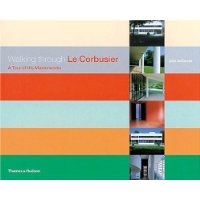| 商家名称 |
信用等级 |
购买信息 |
订购本书 |
|
|
 |
Walking Through Le Corbusier: A Tour of His Masterworks |
 |
|
 |
Walking Through Le Corbusier: A Tour of His Masterworks |
 |

基本信息·出版社:Thames & Hudson
·页码:192 页
·出版日期:2005年10月
·ISBN:0500512337
·条形码:9780500512333
·装帧:精装
·正文语种:英语
·外文书名:了解勒·柯布西耶: 作品之旅
内容简介 A tour in words and photographs that presents a completely new way of experiencing the architecture of this modern master.Le Corbusier (1887-1965) is an icon of twentieth-century architecture, his status a reflection of his capacity to endow architecture with an expression that evokes the spirit of his epoch.
This book features some of Le Corbusier's most important European buildings, complemented by others that are less well known. The photographs, taken sequentially by the author, provide a narrative description of each building and are supported by literary and graphic data that provide a single conceptual and visual argument.
Each "walking through" is accompanied by an introduction that brings together the architect's main ideas about the building; at least one floor plan, which pinpoints the position from which the photograph has been taken; phrases by Le Corbusier relating directly to what is shown in the image; drawings by the architect of certain details; and images from other Le Corbusier buildings that enlarge on the discussion or elucidate a point. Over 300 color illustrations.
作者简介 José Baltanás teaches at the ESDI School of Advanced Design (Ramon Llull University) and the ELISAVA School of Advanced Design (Pompeu Fabra University), both in Barcelona.
专业书评 From Publishers Weekly Le Corbusier's architectural legacy is systematically revealed in this overview of a dozen "masterworks," as selected by Baltanás, a professor of architecture at Ramon Llull and Pompeu Fabra Universities. Moving chronologically, Baltanás offers clear introductions, followed by upwards of 30 original photographs per site. Each image simulates the perspective of a self-guided visitor. Long captions, detailed diagrams and a liberal sprinkling of quotes and drawings from Le Corbusier's journals and published works further illuminate each building. The overall effect pays homage to "the languages of drawing, photography, and writing" that intersect in "Le Corbusier's creative and instinctive world." But problems arise in the choice of "masterworks." For example, the first four selections-Villa Fallet, Villas Stotzer and Jaquemet, Villa Jeanneret-Perret, and Villa Schwob-represent, in a matter of speaking, the pre-history of Le Corbusier. They are provincial, domestic designs by Charles-Edouard Jeanneret (he only took the name Le Corbusier when he was 33), not maverick conceptions by Le Corbusier, the cosmopolitan master and inventor of the "The Five Points of a New Architecture," a transformation not addressed by Baltanás. The result is a strange combination: the book "makes it possible to follow Le Corbusier's creative evolution over the course of his professional life," however, readers are left to generate their own conclusions from Baltanás' cut and paste job of the facts. Those already familiar with the major themes of 20th-century architecture should expect a clean overview of a key figure. The uninitiated should expect a challenge.
Copyright © Reed Business Information, a division of Reed Elsevier Inc. All rights reserved.




